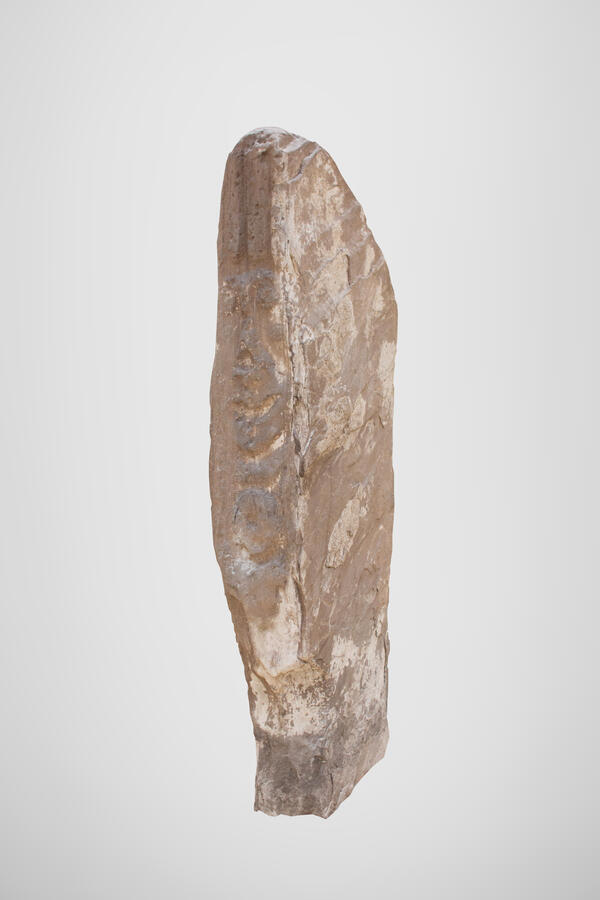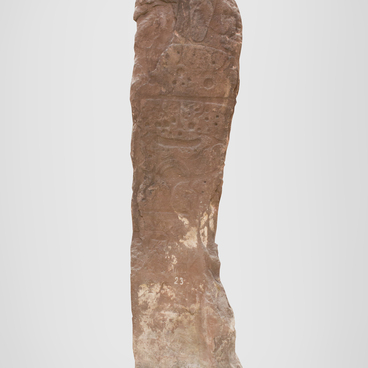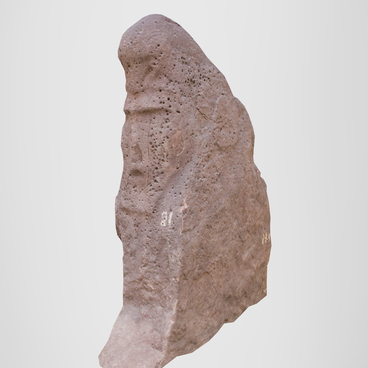This stela was found in 1911 during excavation work on the left bank of the Askiz River, above the confluence of the Baza River, near the former Efimov ulus in the southeastern part of the Khakass-Minusinsk Basin. In 1954, ethnographer and archaeologist Albert Lipsky transported it to the Khakass Regional Museum of Local History.
The statue was made of Devonian sandstone between the end of the 3rd and the beginning of the 2nd millennium BC and belongs to the Okunev archaeological culture. It is named after the Okunev ulus burial ground, which the ethnographer and archaeologist Sergei Teploukhov dug up and studied in 1928.
In the upper part of the found massive stela, the ancient master engraved an image — this is an anthropomorphic, or humanoid, mask with the outlined contours of the forehead and chin. Three wide rays go up from its upper contour, and just below the chin there is a sign in the form of a circle with four rays. At a later time, round pits were carved on the nose and left cheek.
In the art of the Khakass-Minusinsk Basin, images of the sun and its various emblems and signs are often found. This fact suggests that the cult of the sun was very widespread in the beliefs of the ancient population of these places.
Five masks are carved on the western edge of the statue. The upper one depicts the sun of the underworld. The Okunevites probably believed that the road to the upper heavenly world went in the direction of the sun rise, and therefore they always put their cult statues in masks to the east.
The road to the underworld headed towards sunset, where the sun was hiding. That was why the western faces of the carvings usually had upward-crawling snakes — inhabitants of the underworld. Or they made concentric circles — signs of the moon, considered the underworld’s underworld sun.
A mask is engraved on the left side plane, which belongs to the group of late Okunev images. This is evidenced by the lack of her contour. In the upper part, two eyes were placed in the form of ovals with dots in the middle. Above them, in the center, they depicted an oval without a pupil — the third eye. The eyes are underlined by lines in the form of brackets, which probably represent the nose. Below is an oval groove — a mouth, along the edges of which signs in the form of open triangles are carved, and under them there are two ovals and a horizontal line with forked ends. An animal is depicted on the right side edge of the statue, presumably a wolf.
The statue was made of Devonian sandstone between the end of the 3rd and the beginning of the 2nd millennium BC and belongs to the Okunev archaeological culture. It is named after the Okunev ulus burial ground, which the ethnographer and archaeologist Sergei Teploukhov dug up and studied in 1928.
In the upper part of the found massive stela, the ancient master engraved an image — this is an anthropomorphic, or humanoid, mask with the outlined contours of the forehead and chin. Three wide rays go up from its upper contour, and just below the chin there is a sign in the form of a circle with four rays. At a later time, round pits were carved on the nose and left cheek.
In the art of the Khakass-Minusinsk Basin, images of the sun and its various emblems and signs are often found. This fact suggests that the cult of the sun was very widespread in the beliefs of the ancient population of these places.
Five masks are carved on the western edge of the statue. The upper one depicts the sun of the underworld. The Okunevites probably believed that the road to the upper heavenly world went in the direction of the sun rise, and therefore they always put their cult statues in masks to the east.
The road to the underworld headed towards sunset, where the sun was hiding. That was why the western faces of the carvings usually had upward-crawling snakes — inhabitants of the underworld. Or they made concentric circles — signs of the moon, considered the underworld’s underworld sun.
A mask is engraved on the left side plane, which belongs to the group of late Okunev images. This is evidenced by the lack of her contour. In the upper part, two eyes were placed in the form of ovals with dots in the middle. Above them, in the center, they depicted an oval without a pupil — the third eye. The eyes are underlined by lines in the form of brackets, which probably represent the nose. Below is an oval groove — a mouth, along the edges of which signs in the form of open triangles are carved, and under them there are two ovals and a horizontal line with forked ends. An animal is depicted on the right side edge of the statue, presumably a wolf.



